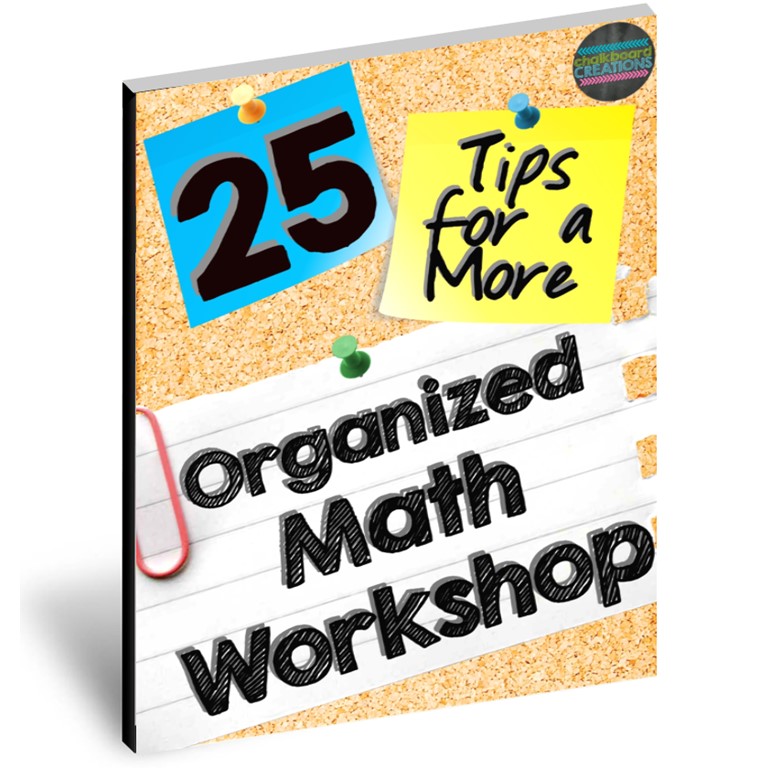 I recently had a question from a lovely blog follower about suggestions on how to schedule her math workshop. It got me thinking, so I decided to do a follow-up to the 7 Habits of a Highly Effective Math Workshop blog series. She was basically asking about how to organize the math workshop if you are short on time and have too many groups. I thought I would share a couple of ideas that might help you out.
I recently had a question from a lovely blog follower about suggestions on how to schedule her math workshop. It got me thinking, so I decided to do a follow-up to the 7 Habits of a Highly Effective Math Workshop blog series. She was basically asking about how to organize the math workshop if you are short on time and have too many groups. I thought I would share a couple of ideas that might help you out.
Let’s pretend that you have too many kids and not enough time to make this math workshop thing happen. For example, let’s say that you have only 55 minutes and you have 4 groups of kids. Your rotation schedule might look like this:
Warm Up (5 minutes)
Mini-lesson (9 minutes)
Rotations 1-4 (9 minutes each)
Review and exit tickets (5 minutes)
You could make this work in your classroom. To me, it seems very rushed. Wouldn’t it be nice to create a little more room in the schedule? You have a couple of options:
1. Have math workshop only a couple of days a week.
Explanation: This is a great option if you still want the flexibility to spend the other days with different types of whole group teaching and learning. The other days might consist of whole group activities or teaching with interactive journals. Jen from Runde’s Room blog has amazing math journal resources. They are great for teaching new concepts, but they do take most of the class period to complete. If you did math workshop only a couple of days of the week, you could either follow the schedule above, or you could meet with each group once. For example:
- Monday: Whole Group Teaching (with a game such as a math scavenger hunt or scoot with task cards)
- Tuesday: Interactive Math Journal
- Wednesday: Math Workshop (See chart)
- Thursday: Math Workshop (See chart)
- Friday: Assessment
Pros: This schedule is great for people who are really wanting to incorporate other teaching strategies into their math block time as well as math workshop. With this format, you could also rearrange the schedule to meet with the lowest group on both days by adjusting the number of groups.
Cons: The biggest con of this plan is that you only get to meet with each group once a week. However, this is a great option to dip your feet into math workshop without diving all the way in.
Note: On the example chart below, Group 1 would be your lowest students (you see them first) and Group 6 would be your highest students. Group 6 is the only group completing the “Independent Practice” before “Teacher Time.”

2. Rotate through the groups throughout the week.
Explanation: I sat down with my wonderful husband and he helped me come up with a sample 5 day schedule that includes 4 groups (by ability level). In this schedule, the lowest group is meeting the teacher every day. The lower middle group meets with the teacher 4 times a week, and the highest 2 groups meet with the teacher twice a week. In this scenario, all the groups would visit each center at least once. You can also use just the Monday and Tuesday section if you are only wanting to do a couple of days of math workshop.
Pros: I really like that you get to meet with your lowest group every day. There are some kids who really need that instruction each class. However, you still get to meet with your highest group 3 times a week, so you don’t have to feel like they are not getting the attention that they need.
Cons: This schedule is obviously a little more complicated. You would definitely need to have it posted and possibly would have to change it daily. (However, this could be one of your classroom jobs.)

3. Meet with two groups at once.
Explanation: In this scenario, you would have more groups, but you would meet with two groups at once during teacher time. In the sample schedule, there are 6 groups and 4 centers in addition to teacher time. Each group would go through the other 4 centers twice a week.
Pros: The upside to this schedule is that you get to meet with every student every day. Also, the groups are much smaller. The benefit of this is that the students are more separated, and this can help with classroom management. Really large groups can sometimes cause more behavioral problems.
Cons: The biggest downside to this schedules is that you have more students when you are teaching your small groups. Depending on how large your class is, this might end up being too much for you. However, I believe that teaching a larger group of students in a math workshop is still more effective than whole group teaching. It is still easier to monitor and field questions from 8-10 students than 30 kids!

I hope that this post helps take away the stress headache of at least one teacher who is trying desperately to get their math workshop schedule to work.
Leave a comment and let me know how you schedule YOUR math workshop!





1 comment on “3 Ways to Make Math Workshop Fit Your Schedule”